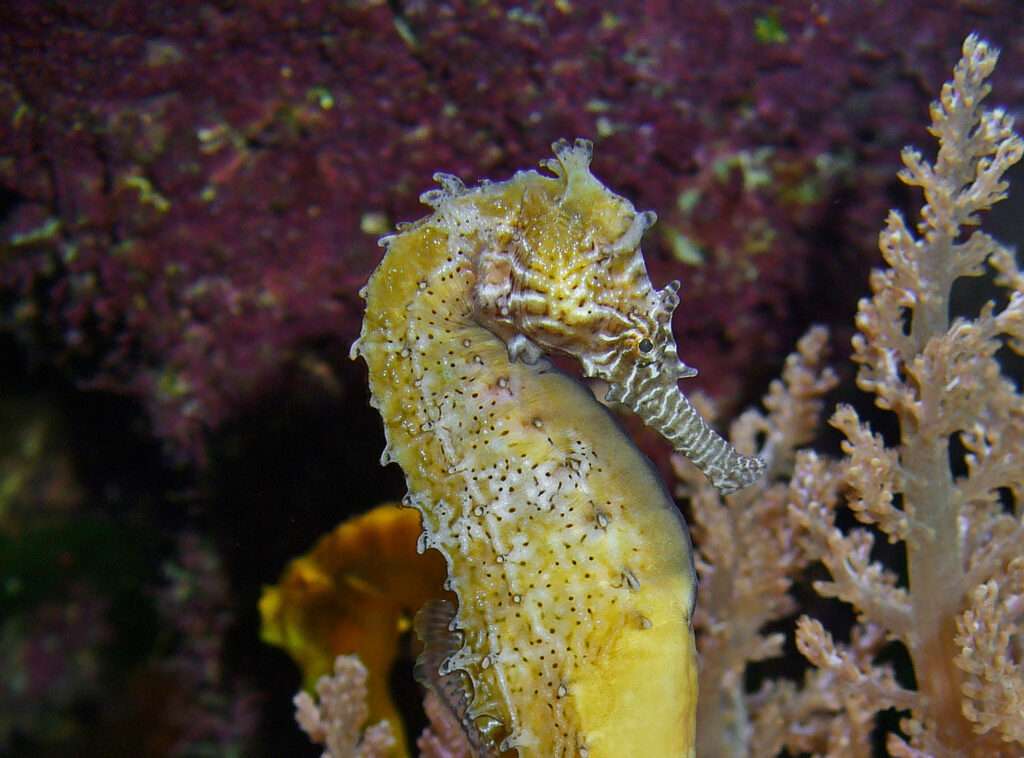
The precise number of tiger tail seahorses worldwide is unknown. According to a few studies, some islands in the Philippines once had 20 tiger-tail seahorses per square meter, but this is no longer the case as a result of a decline in the species’ population. Cyanide fishing, which harms the environment, is frequently used to catch tropical fish for aquariums. Additionally, the seahorse, which has posed a serious threat to this species, is used in traditional Chinese medicine.
The Indo-Pacific region, including Malaysia, Vietnam, Singapore, and as far east as the Philippines, is home to seahorses, which are gregarious creatures that travel in pairs or groups throughout tropical waterways. A herd is the name for a collection of seahorses.
Origin and Habitat
Tiger tail seahorse, is a small seahorse that inhabits the mud and sandy bottoms of continental shelves that are close to the shore as well as coral reef systems along the coasts of Indonesia, Taiwan, Sri Lanka and other nearby countries. They also live in seaweed rafts, where they cling to the flora with their tails. In the Indo-Pacific Ocean, they are common.
Seahorses need fixed supports for their prehensile tails to loop around. Gorgonians and plastic plants make wonderful artificial or natural perches. Seahorses do best in a tank with little water flow because they are weak swimmers. In captivity, seahorses prefer a tall tank. Seahorses do quite well in the homemade seahorse tank. They move through the entire tank during the day, spending time on the water’s surface and scanning the substrate for potential prey.

Diet
The Tiger tail Seahorse is a skilled predator that feeds on amphipods and other small crustaceans that are found in living rock. It lives in the wild. Seahorses should be fed vitamin-enriched frozen or freeze-dried Mysis Shrimp that is still alive if they eat it. Food should be available to seahorses for 20 to 30 minutes each time they are fed, multiple times throughout the day. When compared to wild-caught seahorses, tank-raised seahorses are usually trained to accept frozen or freeze-dried mysid shrimp from a young age and will adjust to your tank far more quickly.
As a feeder, the tiger tail seahorse is not combative. Before eating, this fish will carefully inspect every bit of prospective food. The Tiger tail will eventually starve to death if tanked with more aggressive feeders, as will almost every Seahorse.
Reproduction
Monogamous seahorses have tiger tails! There is love in the seahorse community! When ready to mate, the male dances, changes color, shows his pouch obnoxiously, and moves around actively in front of the female. Their courtship dance might take up to a week before mating. The female will dance with the male, entwine their tails, and lay eggs in his pouch if she is attracted to him. Only one female can supply eggs to the male. The male’s brood pouch can hold up to 2,000 eggs from the female for fertilization. The male cares for and feeds the young in his pouch for one to four weeks. This seahorse species regularly lays eggs, with brood sizes varying from 195 to 626. (Average 360 eggs).
Physical Appearance
The most typical design is switching between yellow and black. From the belly to the tip of the tail, there are stripes. These sea horses are typically discovered in couples on sponge gardens, kelp, coral reefs, and floating sargassum. It is a nocturnal species.
Table





